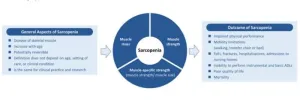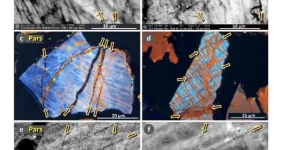(Press-News.org) DURHAM, N.C. – While the liver is one of the body’s most resilient organs, it is still vulnerable to the ravages of stress and aging, leading to disease, severe scarring and failure. A Duke Health research team now might have found a way to turn back time and restore the liver.
In experiments using mice and liver tissue from humans, the researchers identified how the aging process prompts certain liver cells to die off. They were then able to reverse the process in the animals with an investigational drug.
The finding, which appears in the journal Nature Aging, holds high promise for the millions of people who have some degree of liver damage – livers that are essentially old due to the metabolic stresses of high cholesterol, obesity, diabetes or other factors.
“Our study demonstrates that aging is at least partially reversible,” said senior author Anna Mae Diehl, M.D., the Florence McAlister Distinguished Professor of Medicine at the Duke University School of Medicine. “You are never too old to get better.”
Diehl and colleagues set out to understand how non-alcoholic liver disease develops into a severe condition called cirrhosis, in which scarring can lead to organ failure. Aging is a key risk factor for cirrhosis among those who have been diagnosed with non-alcoholic liver disease, known as metabolic dysfunction-associated steatotic liver disease, or MASLD. One in three adults worldwide have the disease.
Studying the livers of mice, the researchers identified a genetic signature distinct to old livers. Compared to young livers, the old organs had an abundance of genes that were activated to cause degeneration of hepatocytes, the main functioning cells of the liver.
“We found that aging promotes a type of programmed cell death in hepatocytes called ferroptosis, which is dependent on iron,” Diehl said. “Metabolic stressors amplify this death program, increasing liver damage.”
Armed with their genetic signature of old livers, the researchers analyzed human liver tissue and found that the livers of people diagnosed with obesity and MASLD carried the signature, and the worse their disease, the stronger the signal.
Importantly, key genes in the livers of people with MASLD were highly activated to promote cell death through ferroptosis. This gave the researchers a definitive target.
“There are things we can use to block that,” Diehl said.
Again turning to mice, the researchers fed young and old mice diets that caused them to develop MASLD. They then gave half the animals a placebo drug and the other half a drug called Ferrostatin-1, which inhibits the cell death pathway.
Upon analysis after treatment, the livers of the animals given Ferrostatin-1 looked biologically like young, healthy livers -- even in the old animals that were kept on the disease-inducing diet.
“This is hopeful for all of us,” Diehl said. “It’s like we had old mice eating hamburgers and fries, and we made their livers like those of young teenagers eating hamburgers and fries.”
Diehl said the team also looked at how the ferroptosis process in the liver impacts the function of other organs, which are often damaged as MASLD progresses. The genetic signature was able to differentiate between diseased and healthy hearts, kidneys and pancreases, indicating that damaged livers amplify ferroptotic stress in other tissues.
“Together, we’ve shown that aging exacerbates non-alcoholic liver disease by creating ferroptic stress, and by reducing this impact, we can reverse the damage,” Diehl said.
In addition to Diehl, study authors include Kuo Du, Liuyang Wang, Ji Hye Jun, Rajesh K. Dutta, Raquel Maeso-Díaz, Seh Hoon Oh and Dennis C. Ko.
The study received funding support from the 2021 AASLD Pinnacle Award, the National Institutes of Health (R01 AA010154, R01 DK077794, R56 DK134334); and Boehringer Ingelheim Pharmaceuticals, Inc.
###
END
A study conducted by researchers at Baylor College of Medicine and collaborating institutions reveals the molecular events leading to osteogenesis imperfecta type V, a form of brittle bone disease caused by a mutation in the gene IFITM5.
The mutation blocks the normal development of bone stem cells into mature cells, which would form healthy bones. Instead, the mutation leads to the formation of bones that are extremely brittle. Children with this disorder have recurrent fractures, bone deformities, chronic pain and other complications. ...
New research led by UCLA Health confirms that both Tai Chi and cognitive behavioral therapy can reduce insomnia in breast cancer survivors but also may provide additional health benefits by reducing inflammation and bolstering anti-viral defenses.
Chronic insomnia is one of the most prominent symptoms experienced among cancer survivors and poses significant health concerns, including the risk of inflammatory disease that could increase the risk of cancer recurrence.
About 30% of breast cancer survivors are reported to have insomnia, which is twice the rate of the general population. While previous research has shown cognitive behavioral therapy and mind-body ...
Measuring energy consumption derived from digital activity from a scientific point of view is the challenge faced by Hiili, S.L., a company recently formed and driven by two researchers from the Universidad Carlos III de Madrid (UC3M), Ángel and Rubén Cuevas Rumín, from the Telematics Engineering Department. Specifically, they develop technological solutions that combine Internet measurement techniques and Artificial Intelligence (AI) to make an accurate estimate of the energy consumption of a company's ...
EMBARGOED FOR RELEASE UNTIL 4 P.M. ET, WEDNESDAY, JUNE 26, 2024
MINNEAPOLIS – Moderate levels of physical activity and fitness may be linked to a reduced risk of amyotrophic lateral sclerosis (ALS) later in life, according to a new study published in the June 26, 2024, online issue of Neurology®, the medical journal of the American Academy of Neurology. The study only found an association between physical activity and risk of ALS in male participants, not female participants.
ALS is a rare, progressive neurodegenerative disease that affects nerve cells in the brain and the spinal cord. People with ALS lose the ability to initiate ...
EMBARGOED FOR RELEASE UNTIL 4 P.M. ET, WEDNESDAY, JUNE 26, 2024
MINNEAPOLIS – A drug used to prevent migraine may also be effective in people with migraine who experience rebound headaches, according to a new study published in the June 26, 2024, online issue of Neurology®, the medical journal of the American Academy of Neurology.
People with chronic migraine who overused pain medication had fewer monthly migraine and headache days and fewer days using pain medication when taking the migraine prevention drug atogepant.
“There is a high prevalence of pain medication ...
Dr. Zhen Mei, a clinical pathologist, and Dr. Vivian Chang, a pediatric hematologist-oncologist, both at UCLA Health, have been awarded $30,000 from the American Society of Hematology to revise blood cell ranges for people with Duffy-null Associated Neutrophil Count, which is also known as Duffy-negative.
Those who are Duffy-negative, estimated to be two out of three people identifying as Black in the U.S., lack Duffy antigens on the surface of their red blood cells as a mechanism to resist malaria. This helps provide protection but ...
TAMPA, Fla. — Ovarian cancer, often diagnosed at an advanced stage, presents significant treatment challenges because patients tend to develop resistance to conventional therapies quickly. Despite aggressive treatment, recurrence rates remain high, and managing this disease effectively requires innovative approaches. Poly-adenosine ribose polymerase (PARP) inhibitors have emerged as a treatment option, targeting specific DNA repair mechanisms in cancer cells. However, their use is often limited ...
“[...] the development of a global conceptual definition of sarcopenia signifies a new dawn for this muscle disease.”
BUFFALO, NY- June 26, 2024 – A new editorial paper was published in Aging (listed by MEDLINE/PubMed as "Aging (Albany NY)" and "Aging-US" by Web of Science) Volume 16, Issue 11, entitled, “Global consensus for sarcopenia.”
In this new editorial, researchers Ben Kirk, Peggy M. Cawthon, and Alfonso J. Cruz-Jentoft from the University of Melbourne and Western Health discuss the global societal issue of skeletal muscle loss and weakness, termed Sarcopenia. Low muscle ...
DURHAM, NC – Researchers have discovered a clue in Italian limestone that helps explain a mass extinction of marine life millions of years ago, and may provide warnings about how oxygen depletion and climate change could impact today’s oceans.
“This event, and events like it, are the best analogs we have in Earth's past for what is to come in the next decades and centuries,” said Michael A. Kipp, an earth and climate science assistant professor at Duke University. Kipp co-authored a study published June 24 in the Proceedings of the National Academy of Sciences that measures oxygen loss ...
(Santa Barbara, Calif.) — Researchers continue to expand the case for the Younger Dryas Impact hypothesis. The idea proposes that a fragmented comet smashed into the Earth’s atmosphere 12,800 years ago, causing a widespread climatic shift that, among other things, led to the abrupt reversal of the Earth’s warming trend and into an anomalous near-glacial period called the Younger Dryas.
Now, UC Santa Barbara emeritus professor James Kennett and colleagues report the presence of proxies associated with the cosmic airburst ...


